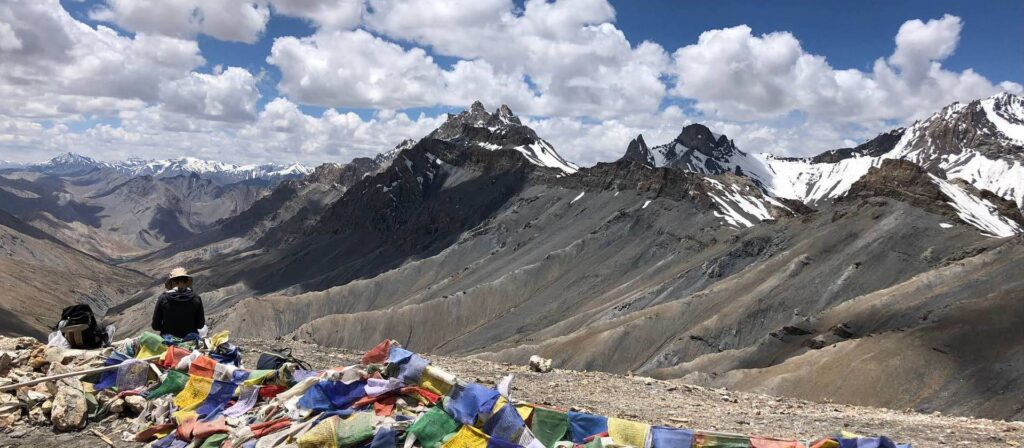Introduction
The Markha Valley trek is an ideal hike for those who want to experience both stunning Himalayan landscapes and authentic Tibetan culture. Yaks graze on green plains at an elevation of 5,000 meters, white snow-covered peaks higher than 6,000 meters, expansive valleys surrounded by huge, rocky mountains, and a strong, deeply ingrained Tibetan culture.
Even though Markha Valley is one of the most well-known treks in Ladakh, it is a thousand times more authentic than the well-known treks available in Nepal.
Ladakh’s tourism industry is still developing, so you can currently spend hours wandering about Markha without encountering anyone other than Tibetan herders.
A tributary of the Zanskar river by the name of Markha, the trip follows it. The valley is shaped by the large, rocky mountains that surround this river. Numerous Tibetan communities that have evolved into small villages with mud-brick homes and Buddhist gompas can be found all along the valley.
This area was completely cut off from modern society for decades before being found in the 19th century. Today, the few hikers that travel through during the summer months provide a living for the Tibetans of Markha Valley.
How to reach the Destination of the Trek
Depending on where you start, you need a minimum of 4 and a maximum of 9 days:
Spitok –
From Spitok, it takes 6 to 9 days of walking to reach the destination. You traverse difficult terrain for the first 2-3 days (40 km) as you make your way to the 4,970m-high Ganda La pass. From there, you begin to descend until you reach the Markha river itself.
Chilling –
Since this location is on the Markha River itself, you can Guest posting sites skip the first two to three days of travel. Trekkers need between 4 and 6 days to complete the trail from Chilling. No, you don’t at all require a guide. It shouldn’t be difficult for you to complete it alone. I’ll tell you why.
Local Tibetans and shepherds –
If the smell of animal excrement throws you off course, don’t worry; you’ll come across a lot of shepherds along the path who will be leading their herd and have horses that you can ask for instructions.
Tibetan villages:
Every 2-4 hours, you will also come across Tibetan villages where you can inquire as to whether you are heading on the right route or not.
Taxi fare from Leh to Chilling is approximately 2,800INR (43USD). I advise you to find a local who can drive you there on a motorcycle if you don’t have somebody to share it with. I spent 1500INR (23USD).
Homestays and tents both cost 1,200INR (16.50USD), which includes dinner, breakfast, and a picnic lunch box.
return transportation to Leh Taxis to Leh from Shang Sumdo (the destination) cost 2,500INR (40USD). However, sometimes, local transportation is available in the morning.
Chilling is 65 kilometers from Leh and is accessible in one hour and 20 minutes. It is simple to reserve a taxi for 2,800INR ($43).
Unofficially, you can find a motorcycle taxi if you can’t find somebody to share it with. How? Just inquire at the various organizations.
Asking around will help you find one because the majority of them will say they don’t provide this service. I spent Rs. 1500 ($23).
Where is Markha valley hike ends
The Markha Valley hike ends in Shang Sumdo, which is also the first village that is accessible by car on the route from Shang Sumdo to Leh. Taxis will pick you up and take you to Leh for 2,500INR ($43).
Once more, if you are the only hiker, you have two options: wait for additional hikers to arrive.
Occasionally, local taxis are leaving at 6 am. You just need to be lucky. Ask anybody around for this information.
Sometimes local taxis are leaving at six in the morning. All you need is a little luck. Inquire anywhere for this information.
The hardest portion of the trek
The hardest portion of the first day is merely the first 5 kilometers, where you must climb to get to the Markha Valley itself. Then it flattens out totally.
The largest village you’ll pass is Skyu, where you can purchase a cooked supper.
The river runs through a valley that gets greener as you travel further, yet the obdurate mountains in the distance are brownish and desolate.
There are a few homestay possibilities in Sara, a village of only a few cottages. But instead of sleeping there, I did so in a lovely campground just a few kilometers away. It was situated on a lush plain and was the ideal place to stay the night, unwind, and socialize with other hikers.
The hike’s shortest, flattest, and most leisurely section is here. The mountains are crisper but the scene is largely unchanged from the day before.
Although you could certainly continue trekking to a different village, Markha is a unique location worth visiting for half a day.
Since it is the valley’s capital, there are more attractions in the hamlet, including a few Buddhist gompas, as well as people working in the fields, interacting with kids, and taking in the scenery.
